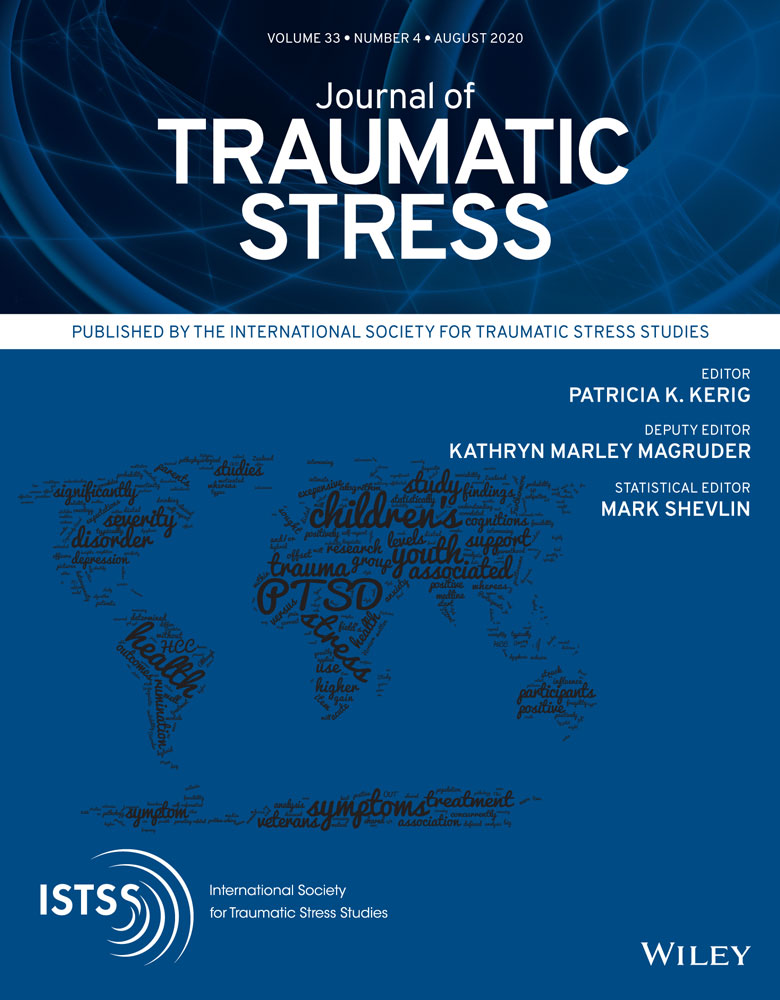Predictors of Attrition Among Young Children Receiving Trauma-Focused Therapy
This research did not receive any specific grant from funding agencies in the public, commercial, or not-for- profit sectors.
Abstract
enFindings from studies of predominately school-aged children indicate that few children complete trauma-focused treatment; however, researchers have not specifically examined risk factors for dropout among young trauma-exposed children. The purpose of the present study was to investigate risk factors for attrition among young children receiving trauma-focused therapy. Study participants were 189 treatment-seeking children aged 3–5 years (M = 4.86 years, SD = 0.71; 54.1% female, 47.7% White) and their nonoffending legal guardian(s). Child and family characteristics, number of traumatic events, and pretreatment posttraumatic stress symptoms (PTSS) were examined in relation to two attrition definitions: (a) clinician-rated dropout and (b) whether the child received an adequate treatment dose (i.e., 12 or more sessions). Although 70.3% of children prematurely terminated therapy per their clinician, a nearly equivalent portion (67.4%) received an adequate treatment dose. Family characteristics were largely not associated with attrition, although residing farther from the clinic was related to clinician-rated treatment dropout, OR = 0.96. As expected, higher levels of externalizing symptoms were associated with clinician-rated dropout and inadequate dose status, ORs = .95 and .96, respectively, whereas lower levels of trauma-related anger were related to clinician-rated treatment completion, OR = 1.03, and lower levels of PTSS and sexual concerns corresponded with an increased likelihood the child received an inadequate treatment dose, ORs = 1.03 and 1.02, respectively. Thus, child and family factors appear to play a small role in predicting attrition; however, higher levels of externalizing problems and lower levels of PTSS may increase the risk for dropout.
Resumen
esSpanish Abstracts by Asociación Chilena de Estrés Traumático (ACET)
Predictores de Deserción entre Niños Pequeños que Reciben Terapia Centrada en el Trauma
DESERCIÓN EN NIÑOS EN TERAPIA FOCALIZADA EN TRAUMA
Los resultados de estudios de niños predominantemente en edad escolar indican que pocos niños completan el tratamiento centrado en el trauma; sin embargo, los investigadores no han examinado específicamente los factores de riesgo de abandono escolar entre los niños pequeños expuestos a traumas. El propósito del presente estudio fue investigar los factores de riesgo de deserción entre los niños pequeños que reciben terapia centrada en el trauma. Los participantes del estudio fueron 189 niños en busca de tratamiento de edades comprendidas entre los 3 y los 5 años (M = 4.86 años, DE = 0.71; 54.1% mujeres, 47.7% blancos) y sus tutores legales no infractores. Las características del niño y la familia, el número de eventos traumáticos y los síntomas de estrés postraumático (SEP) antes del tratamiento se examinaron en relación con dos definiciones de deserción: (a) abandono calificado por el médico y (b) si el niño recibió una dosis de tratamiento adecuada (es decir, 12 o más sesiones). Aunque el 70.3% de los niños interrumpieron prematuramente la terapia según su médico, una porción casi equivalente (67.4%) recibió una dosis de tratamiento adecuada. Las características familiares no se asociaron en gran medida con la deserción, aunque residir más lejos de la clínica se relacionó con el abandono del tratamiento calificado por el médico, OR = 0.96. Como se esperaba, los niveles más altos de síntomas externalizantes se asociaron con el abandono calificado por el médico y el estado de dosis inadecuado, ORs = .95 y .96, respectivamente, mientras que los niveles más bajos de ira relacionada con el trauma se relacionaron con la finalización del tratamiento calificado por el médico, OR = 1.03 , y los niveles más bajos de SEP y preocupaciones sexuales se correspondieron con una mayor probabilidad de que el niño recibiera una dosis de tratamiento inadecuada, OR = 1.03 y 1.02, respectivamente. Por lo tanto, los factores del niño y la familia parecen jugar un papel pequeño en la predicción de la deserción; sin embargo, niveles más altos de problemas de externalización y niveles más bajos de SEP pueden aumentar el riesgo de abandono escolar.
抽象
zhTraditional and Simplified Chinese Abstracts by the Asian Society for Traumatic Stress Studies (AsianSTSS)
簡體及繁體中文撮要由亞洲創傷心理研究學會翻譯
Predictors of Attrition Among Young Children Receiving Trauma-Focused Therapy
Traditional Chinese
標題: 年幼兒童接受聚焦創傷治療的治療流失率預測變量
撮要: 過往主要針對在學兒童的研究反映, 很少兒童會完成聚焦創傷的治療。可是, 研究員並未有特別檢視經歷創傷的年幼兒童其中途退出治療的風險因素。本研究的目的, 旨在探查年幼兒童退出聚焦創傷治療的風險因素。樣本為189名年齡介乎3至5歲、尋求治療的兒童(M = 4.86 歲, SD =0.71; 54.1% 女性, 47.7% 為白人), 以及他們並無冒犯性的合法監護人。我們以以下兩種方法來定義治療流失:(a) 臨床治療師報告樣本退出、(b) 樣本有否接受足夠治療)即12個或更多節段(, 並檢視兒童及家庭的特徵、經歷的創傷事件數量、樣本在治療前的創傷後壓力症狀(PTSS)。雖然, 根據臨床治療師報告, 70.3%的兒童提早中止治療, 但有接近同等數量的兒童(67.4%)取得足夠治療。大部分家庭特徵跟治療流失率無關, 但住所離診所較遠跟臨床治療師報告樣本退出治療有關)OR = 0.96(。一如預期, 有較高水平的外化症狀, 跟臨床治療師報告退出治療及沒接受足夠治療有關)分別為ORs = .95 與 .96(;有較低水平的創傷相關憤怒, 則與臨床治療師報告完成治療)OR = 1.03(有關;有較低水平PTSS及性問題, 跟有較大機會沒接受足夠治療有關)分別為ORs = 1.03 與1.02(。因此, 兒童及家庭因素似乎對預測治療流失率沒什麼作用, 但外化問題水平較高及PTSS水平較低可能會增加樣本退出治療的風險。
Simplified Chinese
标题: 年幼儿童接受聚焦创伤治疗的治疗流失率预测变量
撮要: 过往主要针对在学儿童的研究反映, 很少儿童会完成聚焦创伤的治疗。可是, 研究员并未有特别检视经历创伤的年幼儿童其中途退出治疗的风险因素。本研究的目的, 旨在探查年幼儿童退出聚焦创伤治疗的风险因素。样本为189名年龄介乎3至5岁、寻求治疗的儿童(M = 4.86 岁, SD =0.71; 54.1% 女性, 47.7% 为白人), 以及他们并无冒犯性的合法监护人。我们以以下两种方法来定义治疗流失:(a) 临床治疗师报告样本退出、(b) 样本有否接受足够治疗)即12个或更多节段(, 并检视儿童及家庭的特征、经历的创伤事件数量、样本在治疗前的创伤后压力症状(PTSS)。虽然, 根据临床治疗师报告, 70.3%的儿童提早中止治疗, 但有接近同等数量的儿童(67.4%)取得足够治疗。大部分家庭特征跟治疗流失率无关, 但住所离诊所较远跟临床治疗师报告样本退出治疗有关)OR = 0.96(。一如预期, 有较高水平的外化症状, 跟临床治疗师报告退出治疗及没接受足够治疗有关)分别为ORs = .95 与 .96(;有较低水平的创伤相关愤怒, 则与临床治疗师报告完成治疗)OR = 1.03(有关;有较低水平PTSS及性问题, 跟有较大机会没接受足够治疗有关)分别为ORs = 1.03 与1.02(。因此, 儿童及家庭因素似乎对预测治疗流失率没什么作用, 但外化问题水平较高及PTSS水平较低可能会增加样本退出治疗的风险。




